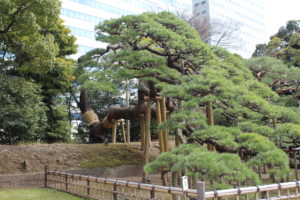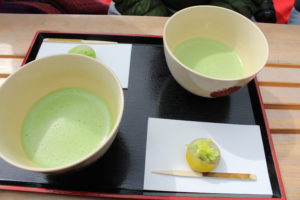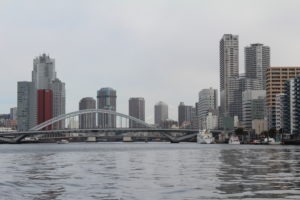Next stop on our Tokyo city tour was the “Hama-Rikyu Gardens”:http://teien.tokyo-park.or.jp/en/hama-rikyu/index.html (fee ¥300 – £2) formerly the family garden of the Tokugawa Shogun.
At the entrance was a 300-year pine planted in 1709 when the 6th Shogun, Lenobu, renovated the garden. It’s one of the largest black pine trees in Tokyo and as befits its age, it was heavily shored up.
Next stop was a bronze statue of Umashimadenomikoto the son of Nigihayahinomikato (both nice short, snappy names: I wonder if they got shortened – Smashy and Nicey come to mind). This statue won a prize in a competition organised to celebrate the Silver Wedding anniversary of Emperor Meiji in 1894.
The garden had two teahouses (Matsu-no-Ochaya and Tsubame-no-Ochaya), both destroyed during World War II, but restored in 2010 and 2015 respectively. We reached the latter by crossing an elegant bridge built in 1707 from Japanese cypress trees. The gravel at the entrance had been raked aesthetically to represent the sea with large boulders resembling the mountains.
Having taken our shoes off at the entrance, and put on the provided slippers, we walked through the tea house onto a wooden deck, where we took off our newly put on slippers. We sat on red felt covered benches in unseasonal sunshine to drink tea.
Yoko explained how to drink the Japanese green tea. I call it tea, but essentially it resembled a mint green pea soup with cappuccino froth. Firstly, we were given a sweet – a soft dough ball with bean curd inside – which was decorated to coincide with the season and flowers. After ensuring the highly decorated front of the handleless cup (yunomi) was facing us, we picked it up with our right hand, whilst supporting it with the palm of our left. The ‘tea’ had to be drunk in exactly three and a half sips and on the final sip, we were able to make an audible slurp – think Arabic burp after a hosted meal. Having wiped the rim, looked under the bottom of the cup to admire any decoration, we returned it to the table. None of us were keen on either the look or the taste – it was nothing like the clear green tea we have at home.
The shoguns were fond of duck hunting and we saw two narrow trenches which the ducks were lured into by decoy ducks. They were unable to fly out due to the short runway and were caught by hawks.
The area where the shoguns arrived by water is now a waterbus station. So after finishing our tour of the gardens we caught one up to the area known as Asakusa passing under 14 bridges on the 40 minute journey.










